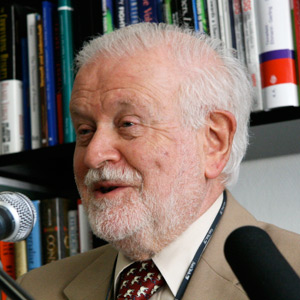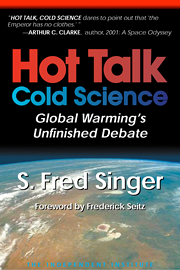Professor Naomi Oreskes, of the University of California in San Diego, claims to be a science historian. One can readily demonstrate that she is neither a credible scientist nor a credible historian; the best evidence is right there in her recent book, Merchants of Doubt: How a Handful of Scientists Obscured the Truth on Issues from Tobacco Smoke to Global Warming, coauthored with Erik Conway. Her science is faulty; her historical procedures are thoroughly unprofessional. She is, however, an accomplished polemicist, who has found time for world lecture tours, promoting her book and her ideological views, while being paid by the citizens of California. Her book tries to smear four senior physicists—of whom I am the only surviving one. I view it as my obligation to defend the reputations of my late colleagues and good friends against her libelous charges.
Oreskes is well-known from her 2004 article in Science that claimed a complete scientific consensus about manmade global warming; it launched her career as a polemicist. Her claim was based on examining the abstracts of some 900 published papers. Unfortunately, she missed more than 11,000 papers through an incorrect Internet search. She published a discreet “Correction”; yet she has never retracted her ideologically based claim about consensus. Al Gore still quotes her result, which has been contradicted by several, more competent studies (by Peiser, Schulte, Bray and von Storch; Lemonick in SciAm, etc).
Turning first to the science, her book discusses acidification, as measured by the pH coefficient. She states that a pH of 6.0 denotes neutrality (page 67, MoD). Let’s be charitable and chalk this off to sloppy proofreading.
Elsewhere in the book (page 29), she claims that beryllium is a “heavy metal” and tries to back this up with references. I wonder if she knows that the atomic weight of beryllium is only 9, compared to, say, uranium, which is mostly 238. A comparison of these two numbers should tell anyone which one is the heavy metal.
Her understanding of the Greenhouse Effect is plain comical; she posits that CO2 is “trapped” in the troposphere—and that’s why the stratosphere is cooling. Equally wrong is her understanding of what climate models are capable of; she actually believes that they can predict forest fires in Russia, floods in Pakistan and China—nothing but calamities everywhere—and tells climate scientists in a recent lecture: If the predictions of climate models have come true, then why don’t people believe them [see this]? Perhaps because people are not gullible.
But the most amazing science blunder in her book is her hypothesis about how cigarette-smoking causes cancer (page 28). She blames it on oxygen-15, a radioactive isotope of the common oxygen-16. I wonder if she knows that the half-life of O-15 is only 122 seconds. Of course, she does not spell out how O-15 gets into cigarette smoke, whether it is in the paper or in the tobacco itself. If the latter, does she believe that the O-15 is created by the burning of tobacco? If so, this would be a fantastic discovery, worthy of an alchemist. Perhaps someone should make her aware of the difference between radioactive and “reactive” oxygen; the two words do sound similar.
I am sure one would find more examples of scientific ignorance in a careful reading of the rest of the book. But why bother?
Having demonstrated her scientific “expertise,” let’s turn to her historical expertise. Any careful historian would use primary sources and would at least try to interview the scientists she proceeds to smear. There is no trace of that in Oreskes’ book. She has never taken the trouble to interview Dr. Robert Jastrow, founder of the NASA-Goddard Institute for Space Studies, and later Director of the Mt. Wilson Astronomical Observatory and founding president of the renowned George C Marshall Institute in Washington, DC. I can find no evidence that she ever interviewed Dr. William Nierenberg, director of the Scripps Institution of Oceanography, who actually lived in San Diego and was readily accessible. And I doubt if she ever even met Dr. Frederick Seitz, the main target of her venom.
Seitz was the most distinguished of the group of physicists that are attacked in the book. He had served as President of the US National Academy of Sciences and of the American Physical Society, and later as President of Rockefeller University. He had been awarded numerous honorary degrees from universities here and abroad, as well as the prestigious National Medal of Science from the White House.
Instead of seeking firsthand information in the tradition of historical research, Oreskes relies on secondary or tertiary sources, quoting people who agree with her ideology. A good example of this is her discussion of acid rain and of the White House panel (under Reagan, in 1982) chaired by Bill Nierenberg, on which I also served. Here she relies on what she was told by Dr. Gene Likens, whose research funding depends on portraying acid rain as a very serious environmental problem. It most definitely is not—and indeed disappeared from view as soon as Congress passed legislation designed to reduce the effect.
An amazing discovery: I found that Oreskes gives me credit (or blames me) for inventing “cap-and-trade,” the trading of emission rights under a fixed cap of total emissions (see pp. 91-93). I had never claimed such a priority because I honestly don’t know if this idea had been published anywhere. It seemed like the natural thing to suggest in order to reduce total cost—once an emission cap had been set. My example involved smelters that emit SO2 copiously versus electric utilities that burn coal containing some sulfur. I even constructed what amounts to a “supply curve” in which the bulk of the emission control is borne initially by the lowest-cost units. Of course, Likens and some others on the panel, antagonistic to coal-burning electric utilities, objected to having my discussion included in the panel report. Nierenberg solved the problem neatly by putting my contribution into a signed Appendix, thereby satisfying some panel members who did not want be responsible for a proposal that might let some electric utilities off the hook.
We have established so far that Oreskes is neither a scientist of any sort nor a careful professional historian. She is, however, a “pop-psychologist.” It seems she has figured out what motivates the four senior physicists she libels in her book; it is “anti-communism.” Really! This is not only stated explicitly but she also identifies them throughout as “Cold Warriors.”
Well, now we know at least where Oreskes stands in the political spectrum.









